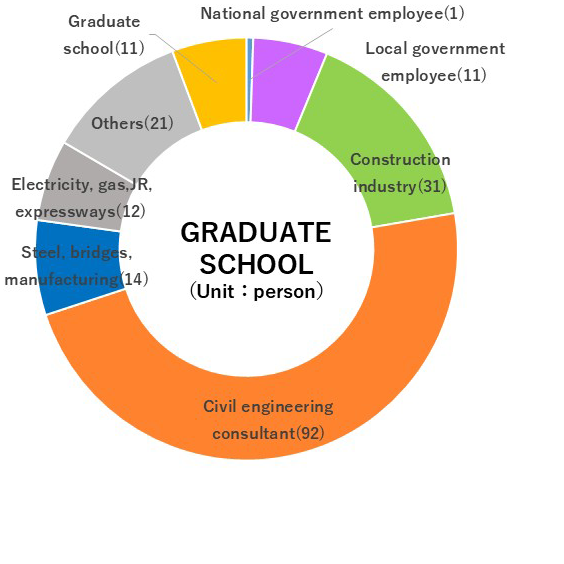Career paths after graduation from university or graduate school
Alumni who have studied social infrastructure, the environment, and disaster mitigation at our university are active in various fields, including government agencies, the construction industry, construction consulting, steel manufacturing, energy infrastructure companies such as electricity and gas, and transportation infrastructure companies such as JR and expressways.
Approximately 40–50% of students who complete four years of university studies go on to graduate school for a master’s degree, where they gain a high level of expertise and logical thinking skills while coming into contact with cutting-edge research topics. After completing graduate school, many students hope to work as specialists in the construction industry, and many go on to find employment as civil servants, in the construction industry, or as construction consultants.
Career path over the past 5 years


Changes over the past five years (numbers are the total for graduates and those who completed the program)
| Employment/School Destination | Fiscal Year of Graduation | ||||
|---|---|---|---|---|---|
| R2 | R3 | R4 | R5 | R6 | |
| National government employee | 2 | 6 | 4 | 1 | 0 |
| Local government employee | 14 | 14 | 16 | 14 | 15 |
| Construction industry | 16 | 21 | 16 | 26 | 11 |
| civil engineering consultant | 20 | 33 | 31 | 17 | 20 |
| Steel, bridges, manufacturing | 6 | 3 | 4 | 2 | 4 |
| Electricity, gas JR, expressways |
9 | 2 | 2 | 7 | 3 |
| Others | 9 | 13 | 6 | 13 | 4 |
| graduate school enrollment | 48 | 32 | 24 | 33 | 35 |
| Total | 124 | 124 | 103 | 103 | 92 |

 JP
JP